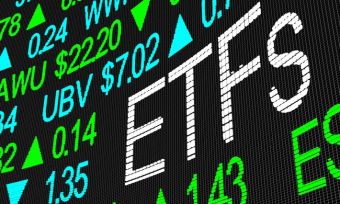Highest return ETFs in Australia
Exchange traded funds (ETFs) are popular among many Aussie investors. So what are some of the best ETFs on our database and how high are their average returns?

Exchange traded funds (ETFs) are popular among many Aussie investors. So what are some of the best ETFs on our database and how high are their average returns?
Highest three-year returns – Australian Broad Based ETFs
Australian Broad Based ETFs track a broad index such as the S&P/ASX 200 or the S&P/ASX 50.
← Mobile/tablet users, scroll sideways to view full table →
| Australian Broad Based ETFs |
1 Year Return |
3 Year Average Annual Return |
5 Year Average Annual Return |
|---|---|---|---|
| iShares Edge MSCI Australia Multifactor ETF |
20.72% | 15.85% | 12.52% |
| Vanguard Ethically Conscious Australian Shares ETF |
14.22% | 14.13% | 12.24% |
| Betashares FTSE RAFI Australia 200 ETF |
15.36% | 14.04% | 15.29% |
| iShares Edge MSCI Australia Minimum Volatility ETF |
16.03% | 13.45% | 11.03% |
| Betashares Australia 200 ETF |
12.38% | 13.03% | 12.83% |
Source: www.canstar.com. Returns sourced from publicly available data from the providers and are effective to October 2025. Past performance is not a reliable indicator of future performance. Table sorted in descending order by 3 Year Average Annual Return, followed by 1 Year Return.
Highest three-year returns – Australian Sector ETFs
Australian Sector ETFs invest in specific sectors of the Australian market, such as banks, financials, resources or property.
← Mobile/tablet users, scroll sideways to view full table →
| Australian Sector ETFs |
1 Year Return |
3 Year Average Annual Return |
5 Year Average Annual Return |
|---|---|---|---|
| Betashares Australian Investment Grade Corporate Bond ETF |
9.44% | 8.53% | 1.39% |
| VanEck Australian Corporate Bond Plus ETF |
7.86% | 6.90% | 1.56% |
| Vanguard Australian Corporate Fixed Interest Index ETF |
6.61% | 5.89% | 1.66% |
| Betashares Australian Bank Senior Floating Rate Bond ETF |
5.27% | 5.65% | 3.31% |
| Betashares Australian Composite Bond ETF |
7.40% | 5.26% | N/A |
Source: www.canstar.com. Returns sourced from publicly available data from the providers and are effective to October 2025. Past performance is not a reliable indicator of future performance. Table sorted in descending order by 3 Year Average Annual Return, followed by 1 Year Return.
Highest three-year returns – Australian Strategy Based ETFs
The investments in Australian Strategy ETFs are selected according to certain investment strategies, such as high-dividend yield or maximised capital growth. They tend to only include a limited number of different Australian stocks, rather than a broad index.
← Mobile/tablet users, scroll sideways to view full table →
| Australian Strategy Based ETFs |
1 Year Return |
3 Year Average Annual Return |
5 Year Average Annual Return |
|---|---|---|---|
| Betashares Geared Australian Equity Fund (hedge fund) |
20.55% | 21.84% | 22.62% |
| Betashares Australian Quality ETF |
17.95% | 19.91% | N/A |
| iShares S&P/ASX Dividend Opportunities ESG Screened ETF |
21.16% | 16.60% | 12.97% |
| VanEck MSCI Australian Sustainable Equity ETF |
13.57% | 14.95% | 11.39% |
| Vanguard Australian Shares High Yield ETF |
16.98% | 14.40% | 16.08% |
Source: www.canstar.com. Returns sourced from publicly available data from the providers and are effective to October 2025. Past performance is not a reliable indicator of future performance. Table sorted in descending order by 3 Year Average Annual Return, followed by 1 Year Return.
Highest three-year returns – International Broad Based ETFs
International Broad Based or Broad Market ETFs work in a very similar way to Australian Broad Based ETFs, except they track broad international share markets, such as the S&P 500.
← Mobile/tablet users, scroll sideways to view full table →
| International Broad Based ETFs |
1 Year Return |
3 Year Average Annual Return |
5 Year Average Annual Return |
|---|---|---|---|
| Betashares NASDAQ 100 ETF |
30.25% | 30.61% | 20.43% |
| Betashares NASDAQ 100 ETF – Currency Hedged |
29.34% | 29.51% | 16.48% |
| iShares Global 100 ETF |
30.64% | 25.99% | 21.47% |
| iShares Global 100 AUD Hedged ETF |
29.42% | 24.55% | 18.88% |
| Betashares Nasdaq 100 Yield Maximiser Fund (managed fund) |
19.98% | 24.15% | N/A |
Source: www.canstar.com. Returns sourced from publicly available data from the providers and are effective to October 2025. Past performance is not a reliable indicator of future performance. Table sorted in descending order by 3 Year Average Annual Return, followed by 1 Year Return.
Compare International Share Trading Platforms
Before you make any decision to invest in an ETF you might want to consider its Product Disclosure Statement (PDS) and Target Market Determination (TMD), as well as any other relevant documentation.
What are Exchange Traded Funds (ETFs)?
ETFs are passively managed investment funds that can be bought and sold on an exchange, such as the Australian Securities Exchange (ASX). Instead of buying shares in one company, investing in an ETF allows you to get a basket of shares or assets from different companies with a single trade.
Many ETFs aim to replicate the performance of an index, such as the S&P/ASX 200 in Australia or the S&P 500 in the United States, or specific assets such as currency or a commodity (like gold, iron ore or agricultural products).
You may be interested in Canstar’s Provider of the Year Award for Exchange Traded Funds, as it recognises the ETF provider that has scored highly across areas such as how closely its ETFs track their benchmark, their associated costs and fees, as well as the information and educational support that the provider offers to investors.
What are the different types of ETFs?
ETFs cover a wide range of asset classes and individual assets. This includes Australian shares, international shares, commodities and currencies. Canstar’s database classifies ETFs into the following types:
- Australian Broad Based ETFs
- Australian Sector ETFs
- Australian Strategy Based ETFs
- International Broad Based ETFs
How to invest in Australia using ETFs
You can invest in Australian or international shares by purchasing ETFs like those listed above. This can be done in the same way you would ordinarily buy shares—which is through a broker. There are two different types of brokers:
Online brokers
Online brokers (also known as online share trading platforms) are generally the most popular form of brokers, as they tend to be more accessible for new investors and charge lower brokerage fees compared to full service brokers. They typically don’t offer recommendations or advice in regards to your financial decisions. If you’re interested in an online share trading platform, Canstar’s Share Trading Platform Awards might be a good place to start, as the awards recognise the providers that deliver outstanding value to customers based on both price and features.
Full service brokers
Full service brokers can offer tailored advice on buying and selling shares, as well as provide research and compile investment plans for customers. They generally charge a higher brokerage fee as a result of providing this professional financial advice.
The kind of broker that’s right for you will depend on your needs, budget and financial goals.
Pros and cons of ETFs
Pros
- Diversification: ETFs can expose you to a diversified portfolio of assets in a single trade. You may also be able to invest in a wider range of markets or assets.
- Transparency: The issuer provides daily information relating to the ETF, including the net asset value (NAV). The NAV is typically calculated by subtracting the fund’s liabilities (debts, financial obligations etc.) from the fund’s assets and dividing the result by the number of units on offer.
- Low cost: ETFs are usually cheaper than actively managed funds.
- Ease of trading: ETFs can be traded on the ASX or another online trading platform during trading hours.
Cons
- Market risk: There’s always the risk that the market an ETF is tracking could fall in value, which will generally lead to the ETF falling in value.
- Currency risk: If the ETF invests in international assets, it will be exposed to currency movements.
- Liquidity risk: Some ETFs invest in non-liquid assets (e.g. emerging market debt), so the ETF provider may find it hard to create or redeem securities.
- Tracking errors: Where the return of the ETF may differ from the index or asset it’s designed to track.
What’s the difference between an ETF and a managed fund?
Most ETFs are passively managed, which means the role of the fund manager is simply to make sure the ETF tracks the value of a specified index or asset. This is in contrast to actively managed funds, where the fund manager aims to outperform a specified benchmark. As a consequence, ETFs generally have lower management fees than actively managed funds. Managed funds tend to also buy and sell securities more frequently, which may incur more brokerage costs.
Generally speaking, managed funds also have minimum investment requirements, whereas ETFs do not—although the broker you choose to buy an ETF through may have one. ETFs can be bought and sold through an online share trading platform or a broker. Managed funds, on the other hand, are not always listed on trading platforms and may require engaging a full service broker in order to invest in them. That being said, managed funds generally allow you to invest additional funds in them without paying a brokerage fee, unlike an ETF which would have an associated fee for each investment transaction.
Things to look out for when investing in ETFs
- The different associated management fees.
- The brokerage costs involved when trading.
- Checking what index or asset the fund is tracking, including the companies in which it’s investing.
- The historical returns—like the ones in the tables above. While these returns are not an indicator of future performance, they can be useful when looking at how an ETF has performed over a period of time.
You can also compare other investment products and platforms with Canstar, such as online share trading platforms, international share trading platforms, term deposits and superannuation funds.
ETF FAQs
Why invest in Exchange Traded Funds (ETFs)?

ETFs can provide you with access to a range of different asset classes that some investors may not ordinarily be able to access (e.g. fixed income securities, currency markets and international equities). As a result of this, ETFs can provide a level of diversification to your portfolio that may be difficult to achieve through singular company investing alone.
ETFs also generally have lower fees and no minimum investment requirements, which make them more cost-effective and accessible to the everyday investor. They’re also typically passively managed, which means they rely less on the skill and experience of a fund manager and more so on the investment approach of the ETF itself.
What is the difference between an Exchange Quoted Managed Funds (EQMFs) and Exchange Traded Funds (ETFs)?

Exchange Quoted Managed Funds (EQMFs), also referred to as active ETFs, are ETFs that have a fund manager who is actively making decisions about what to invest in. This active strategy differs from the passive investment strategies of a regular ETF, as EQMF managers typically aim to beat a set benchmark or index rather than track it. As a result of this, EQMFs will typically have higher fees than ETFs. EQMFs are traded in the same way as ETFs, meaning they can be purchased as units via a broker.
This article was reviewed by our Deputy Finance Editor Alasdair Duncan before it was updated, as part of our fact-checking process.

Nick’s role at Canstar allows him to combine his love of the written word with his interest in finance, having learned the art of share trading from his late grandfather. Nick strives to deliver clear and straightforward content that helps the everyday consumer navigating the world of finance. Nick is also working on a TV series in his spare time. You can connect with Nick on LinkedIn.
- Highest three-year returns – Australian Broad Based ETFs
- Highest three-year returns – Australian Sector ETFs
- Highest three-year returns – Australian Strategy Based ETFs
- Highest three-year returns – International Broad Based ETFs
- What are Exchange Traded Funds (ETFs)?
- What are the different types of ETFs?
- How to invest in Australia using ETFs
- Pros and cons of ETFs
- What’s the difference between an ETF and a managed fund?
- Things to look out for when investing in ETFs




